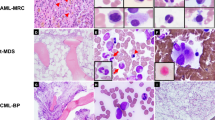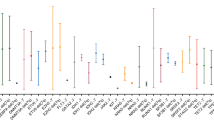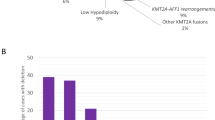Abstract
Deletions of chromosome 6q have been reported in several hematological malignancies, but data are not conclusive regarding their biological and prognostic impact. Therefore, we focused on pediatric patients diagnosed with T-cell lymphoblastic lymphoma (T-LBL) treated uniformly according to the NHL-BFM95 protocol. We used loss-of-heterozygosity (LOH) analysis of 25 microsatellite markers located on chromosome 6q14–q24. Fragment-length analysis was performed on ABI-PRISM3100 Genetic-Analyzer. Eligibility criterion was ⩾3 informative markers. Between April 1995 and March 2003, 185 T-LBL patients were treated according to the NHL-BFM95 protocol. Five-year event-free (EFS) and disease-free survival (DFS) were 79±3 and 87±3% (median follow-up 4.7 [1.2–10.1] years). Sixty-one patients were evaluable for LOH analysis, including 18 out of 23 patients with relapse. EFS and DFS were 67±6 and 69±6% for these 61 patients. Testing of 853 markers in the 61 patients identified the presence of LOH in 19 patients (31%): 13 of the 18 relapse patients and five of the 41 in complete remission (odds ratio 18.7, 95% confidence interval 4.7–75.3). One LOH-positive patient died from treatment-related toxicity. We conclude that LOH on chromosome 6q14–q24 may have conferred a high risk of relapse on our group of children with T-LBL treated according to the NHL-BFM95 protocol.
This is a preview of subscription content, access via your institution
Access options
Subscribe to this journal
Receive 12 print issues and online access
$259.00 per year
only $21.58 per issue
Buy this article
- Purchase on Springer Link
- Instant access to full article PDF
Prices may be subject to local taxes which are calculated during checkout

Similar content being viewed by others
References
Pui CH, Relling MV, Downing JR . Acute lymphoblastic leukemia. N Engl J Med 2004; 350: 1535–1548.
Greaves MF, Wiemels J . Origins of chromosome translocations in childhood leukaemia. Nat Rev Cancer 2003; 3: 639–649.
Mancini M, Vegna ML, Castoldi GL, Mecucci C, Spirito F, Elia L et al. Partial deletions of long arm of chromosome 6: biologic and clinical implications in adult acute lymphoblastic leukemia. Leukemia 2002; 16: 2055–2061.
Schop RF, Kuehl WM, Van Wier SA, Ahmann GJ, Price-Troska T, Bailey RJ et al. Waldenstrom macroglobulinemia neoplastic cells lack immunoglobulin heavy chain locus translocations but have frequent 6q deletions. Blood 2002; 100: 2996–3001.
Cave H, Guidal C, Elion J, Vilmer E, Grandchamp B . A low rate of loss of heterozygosity is found at many different loci in childhood B-lineage acute lymphocytic leukemia. Leukemia 1996; 10: 1486–1491.
Schouten HC, Sanger WG, Weisenburger DD, Armitage JO . Abnormalities involving chromosome 6 in newly diagnosed patients with non-Hodgkin's lymphoma. Nebraska Lymphoma Study Group. Cancer Genet Cytogenet 1990; 47: 73–82.
Rutherford S, Yu Y, Rumpel CA, Frierson Jr HF, Moskaluk CA . Chromosome 6 deletion and candidate tumor suppressor genes in adenoid cystic carcinoma. Cancer Lett 2005; July 28;[E-pub ahead of print].
Abe T, Makino N, Furukawa T, Ouyang H, Kimura M, Yatsuoka T et al. Identification of three commonly deleted regions on chromosome arm 6q in human pancreatic cancer. Genes Chromosomes Cancer 1999; 25: 60–64.
Cooney KA, Wetzel JC, Consolino CM, Wojno KJ . Identification and characterization of proximal 6q deletions in prostate cancer. Cancer Res 1996; 56: 4150–4153.
Cuneo A, Rigolin GM, Bigoni R, de Angeli C, Veronese A, Cavazzini F et al. Chronic lymphocytic leukemia with 6q− shows distinct hematological features and intermediate prognosis. Leukemia 2004; 18: 476–483.
Jackson A, Carrara P, Duke V, Sinclair P, Papaioannou M, Harrison CJ et al. Deletion of 6q16–q21 in human lymphoid malignancies: a mapping and deletion analysis. Cancer Res 2000; 60: 2775–2779.
Offit K, Parsa NZ, Gaidano G, Filippa DA, Louie D, Pan D et al. 6q deletions define distinct clinico-pathologic subsets of non-Hodgkin's lymphoma. Blood 1993; 82: 2157–2162.
Gaidano G, Hauptschein RS, Parsa NZ, Offit K, Rao PH, Lenoir G et al. Deletions involving two distinct regions of 6q in B-cell non-Hodgkin lymphoma. Blood 1992; 80: 1781–1787.
Menasce LP, Orphanos V, Santibanez-Koref M, Boyle JM, Harrison CJ . Deletion of a common region on the long arm of chromosome 6 in acute lymphoblastic leukaemia. Genes Chromosomes Cancer 1994; 10: 26–29.
Zhang Y, Matthiesen P, Harder S, Siebert R, Castoldi G, Calasanz MJ et al. A 3-cM commonly deleted region in 6q21 in leukemias and lymphomas delineated by fluorescence in situ hybridization. Genes Chromosomes Cancer 2000; 27: 52–58.
Sherratt T, Morelli C, Boyle JM, Harrison CJ . Analysis of chromosome 6 deletions in lymphoid malignancies provides evidence for a region of minimal deletion within a 2-megabase segment of 6q21. Chromosome Res 1997; 5: 118–124.
Starostik P, Greiner A, Schultz A, Zettl A, Peters K, Rosenwald A et al. Genetic aberrations common in gastric high-grade large B-cell lymphoma. Blood 2000; 95: 1180–1187.
Sinclair PB, Sorour A, Martineau M, Harrison CJ, Mitchell WA, O'Neill E et al. A fluorescence in situ hybridization map of 6q deletions in acute lymphocytic leukemia: identification and analysis of a candidate tumor suppressor gene. Cancer Res 2004; 64: 4089–4098.
Steinemann D, Gesk S, Zhang Y, Harder L, Pilarsky C, Hinzmann B et al. Identification of candidate tumor-suppressor genes in 6q27 by combined deletion mapping and electronic expression profiling in lymphoid neoplasms. Genes Chromosomes Cancer 2003; 37: 421–426.
Hayashi Y, Raimondi SC, Look AT, Behm FG, Kitchingman GR, Pui CH et al. Abnormalities of the long arm of chromosome 6 in childhood acute lymphoblastic leukemia. Blood 1990; 76: 1626–1630.
Heerema NA, Sather HN, Sensel MG, Lee MK, Hutchinson R, Lange BJ et al. Clinical significance of deletions of chromosome arm 6q in childhood acute lymphoblastic leukemia: a report from the Children's Cancer Group. Leuk Lymphoma 2000; 36: 467–478.
Heerema NA, Sather HN, Sensel MG, Kraft P, Nachman JB, Steinherz PG et al. Frequency and clinical significance of cytogenetic abnormalities in pediatric T-lineage acute lymphoblastic leukemia: a report from the Children's Cancer Group. J Clin Oncol 1998; 16: 1270–1278.
Takeuchi S, Koike M, Seriu T, Bartram CR, Schrappe M, Reiter A et al. Frequent loss of heterozygosity on the long arm of chromosome 6: identification of two distinct regions of deletion in childhood acute lymphoblastic leukemia. Cancer Res 1998; 58: 2618–2623.
Offit K, Louie DC, Parsa NZ, Filippa D, Gangi M, Siebert R et al. Clinical and morphologic features of B-cell small lymphocytic lymphoma with del(6)(q21q23). Blood 1994; 83: 2611–2618.
Whang-Peng J, Knutsen T, Jaffe ES, Steinberg SM, Raffeld M, Zhao WP et al. Sequential analysis of 43 patients with non-Hodgkin's lymphoma: clinical correlations with cytogenetic, histologic, immunophenotyping, and molecular studies. Blood 1995; 85: 203–216.
Mansoor A, Medeiros LJ, Weber DM, Alexanian R, Hayes K, Jones D et al. Cytogenetic findings in lymphoplasmacytic lymphoma/Waldenstrom macroglobulinemia. Chromosomal abnormalities are associated with the polymorphous subtype and an aggressive clinical course. Am J Clin Pathol 2001; 116: 543–549.
Walters R, Kantarjian HM, Keating MJ, Estey EH, Trujillo J, Cork A et al. The importance of cytogenetic studies in adult acute lymphocytic leukemia. Am J Med 1990; 89: 579–587.
Yunis JJ, Frizzera G, Oken MM, McKenna J, Theologides A, Arnesen M . Multiple recurrent genomic defects in follicular lymphoma. A possible model for cancer. N Engl J Med 1987; 316: 79–84.
Foroni L, Sorour A, Sinclair P DV . Loss of heterozygosity (LOH) and microsatellite instability (MSI) of chromosme 6q16–21 identifies a prognostically poor group of childhood and adult T Cell acute lymphoblastic leukemia (ALL) patients. Blood 2003; 102: 606 (abstract).
Tilly H, Rossi A, Stamatoullas A, Lenormand B, Bigorgne C, Kunlin A et al. Prognostic value of chromosomal abnormalities in follicular lymphoma. Blood 1994; 84: 1043–1049.
Burkhardt B, Woessmann W, Zimmermann M, Kontny U, Vormoor J, Doerffel W et al. Impact of cranial radiotherapy on central nervous system prophylaxis in children and adolescents with central nervous system-negative stage III or IV lymphoblastic lymphoma. J Clin Oncol 2006; 24: 491–499.
Bennett JM, Catovsky D, Daniel MT, Flandrin G, Galton DA, Gralnick HR et al. Proposals for the classification of the acute leukaemias: French–American–British (FAB) cooperative group. Br J Haematol 1976; 33: 451–458.
Ludwig WD, Rieder H, Bartram CR, Heinze B, Schwartz S, Gassmann W et al. Immunophenotypic and genotypic features, clinical characteristics, and treatment outcome of adult pro-B acute lymphoblastic leukemia: results of the German multicenter trials GMALL 03/87 and 04/89. Blood 1998; 92: 1898–1909.
Stansfeld AG, Diebold J, Noel H, Kapanci Y, Rilke F, Kelenyi G et al. Updated Kiel classification for lymphomas. Lancet 1988; 1: 292–293.
Jaffe ES, Harris NL, Stein H, Vardiman J . WHO Classification, Tumours of Haematopoietic and Lymphoid Tissue. IARC Press: Lyon, 2001.
Bene MC, Castoldi G, Knapp W, Ludwig WD, Matutes E, Orfao A et al. Proposals for the immunological classification of acute leukemias. European Group for the Immunological Characterization of Leukemias (EGIL). Leukemia 1995; 9: 1783–1786.
Murphy SB . Classification, staging and end results of treatment of childhood non-Hodgkin's lymphomas: dissimilarities from lymphomas in adults. Semin Oncol 1980; 7: 332–339.
Hatta Y, Yamada Y, Tomonaga M, Miyoshi I, Said JW, Koeffler HP . Detailed deletion mapping of the long arm of chromosome 6 in adult T-cell leukemia. Blood 1999; 93: 613–616.
Merup M, Moreno TC, Heyman M, Ronnberg K, Grander D, Detlofsson R et al. 6q deletions in acute lymphoblastic leukemia and non-Hodgkin's lymphomas. Blood 1998; 91: 3397–3400.
Gerard B, Cave H, Guidal C, Dastugue N, Vilmer E, Grandchamp B . Delineation of a 6 cM commonly deleted region in childhood acute lymphoblastic leukemia on the 6q chromosomal arm. Leukemia 1997; 11: 228–232.
Li CY, Chow C, Chan WY . Allelic imbalance mapped to 6q14.1 is associated with loss of expression of 5-HT receptor 1B in non-Hodgkin lymphomas. Diagn Mol Pathol 2004; 13: 69–74.
Kaplan EL, Meier P . Non-parametric estimation from incomplete observations. J Am Stat Assos 1958; 53: 457–481.
Mantel E . Evaluation of survival data and tow new rank order statistics arising in its consideration. Cancer Chemother Rep 1966; 50: 163–170.
Breslow NE, Day NE . Statistical Methods in Cancer Research. 1 – The Analysis of Case–Control Studies. IARC Scientific Publications: Lyon, 2005.
Burger B, Zimmermann M, Mann G, Kuhl J, Loning L, Riehm H et al. Diagnostic cerebrospinal fluid examination in children with acute lymphoblastic leukemia: significance of low leukocyte counts with blasts or traumatic lumbar puncture. J Clin Oncol 2003; 21: 184–188.
Andreasson P, Hoglund M, Bekassy AN, Garwicz S, Heldrup J, Mitelman F et al. Cytogenetic and FISH studies of a single center consecutive series of 152 childhood acute lymphoblastic leukemias. Eur J Haematol 2000; 65: 40–51.
Reiter A, Schrappe M, Ludwig WD, Tiemann M, Parwaresch R, Zimmermann M et al. Intensive ALL-type therapy without local radiotherapy provides a 90% event-free survival for children with T-cell lymphoblastic lymphoma: a BFM group report. Blood 2000; 95: 416–421.
Burkhardt B, Zimmermann M, Oschlies I, Niggli F, Mann G, Parwaresch R et al. The impact of age and gender on biology, clinical features and treatment outcome of non-Hodgkin lymphoma in childhood and adolescence. Br J Haematol 2005; 131: 39–49.
Wang J, Kataoka H, Suzuki M, Sato N, Nakamura R, Tao H et al. Downregulation of EphA7 by hypermethylation in colorectal cancer. Oncogene 2005; 24: 5637–5647.
Eisen T, Easty DJ, Bennett DC, Goding CR . The POU domain transcription factor Brn-2: elevated expression in malignant melanoma and regulation of melanocyte-specific gene expression. Oncogene 1995; 11: 2157–2164.
Akoulitchev S, Chuikov S, Reinberg D . TFIIH is negatively regulated by cdk8-containing mediator complexes. Nature 2000; 407: 102–106.
Liu ZJ, Tanaka Y, Mine S, Morinobu A, Yagita H, Okumura K et al. Functional cooperation of cyclin C and c-Myc in mediating homotypic cell adhesion via very late antigen-4 activation and vascular cell adhesion molecule-1 induction. Blood 1998; 92: 4700–4711.
Attarbaschi A, Dworzak M, Steiner M, Urban C, Fink FM, Reiter A et al. Outcome of children with primary resistant or relapsed non-Hodgkin lymphoma and mature B-cell leukemia after intensive first-line treatment: a population-based analysis of the Austrian Cooperative Study Group. Pediatr Blood Cancer 2005; 44: 70–76.
Acknowledgements
We acknowledge the expert work of Ulrike Meyer, Bettina Paul, Nora Mühlegger (data management) and Edelgard Odenwald and Gabriele Buck (cytomorphology). Central histopathology and immunophenotyping of tissue samples was supported by the Kinder Krebs Initiative (KKI), Buchholz-Holm-Seppensen, Germany. The LOH analysis was performed with the support of the start-up research program of the medical faculty of the Justus-Liebig University, Giessen, Germany.
Author information
Authors and Affiliations
Corresponding author
Additional information
Supplementary Information accompanies the paper on the Leukemia website (http://www.nature.com/leu)
Supplementary information
Rights and permissions
About this article
Cite this article
Burkhardt, B., Bruch, J., Zimmermann, M. et al. Loss of heterozygosity on chromosome 6q14–q24 is associated with poor outcome in children and adolescents with T-cell lymphoblastic lymphoma. Leukemia 20, 1422–1429 (2006). https://doi.org/10.1038/sj.leu.2404275
Received:
Revised:
Accepted:
Published:
Issue Date:
DOI: https://doi.org/10.1038/sj.leu.2404275



